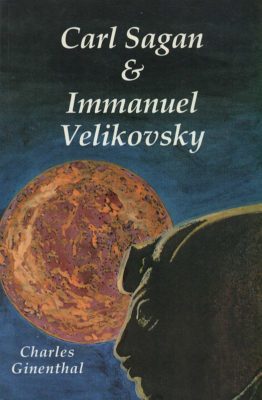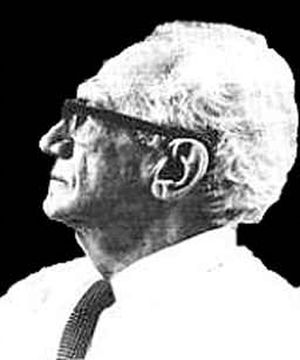 Charles Ginenthal’s book on Sagan’s “ten problems” with Velikovsky’s theories
Charles Ginenthal’s book on Sagan’s “ten problems” with Velikovsky’s theories
Carl Sagan and Immanuel Velikovsky is a book (1995) by Charles Ginenthal, who gives his views on Carl Sagan‘s criticisms of Velikovsky’s work. Ginenthal states:
“Dr. Carl Sagan, a professor of astronomy from Cornell University, a well known public personality and writer of popular books of science, in 1974 at a symposium of the American Association for the Advancement of Science (AAAS) delivered a paper, “An Analysis of Worlds in Collision“. This paper was later edited and presented in a book, Scientists Confront Velikovsky, published by Cornell University Press. The paper was further edited and presented in Sagan’s book Broca’s Brain, under the title “Venus and Dr. Velikovsky”. Sagan’s paper is a critique of Immanuel Velikovsky’s book Worlds in Collision.
“Having read Velikovsky, I also read Sagan’s paper; I thereafter discovered that a group of scientists and scholars had written critiques of Sagan’s analysis. After reading these criticisms I began a search of the literature and over a period of time I became convinced that Sagan’s critique lacked substance. Most surprising was the number of statements made by Sagan that proved to be clearly untrue. Further reading reinforced this discovery of the glaringly unscientific and unscholarly quality of Sagan’s paper. What was much worse, was that it was difficult to imagine that even Sagan was unaware of the misrepresentation of evidence presented as scholarly criticism by him and offered to the public.”
“.. the realization struck that Carl Sagan’s criticisms had been uncritically read by a wide audience. This was soon discovered to be the case among friends and relatives. Seemingly, they had all read Sagan’s side, but not Velikovsky’s. With little or no scientific background with which to judge, they had accepted Sagan’s word on all matters. It was then that I conceived the idea for this book. It is hoped that reading the other side will permit laymen to clarify the issues.”[1]Charles Ginenthal, Carl Sagan and Immanuel Velikovsky, 1995 New Falcon Publications, 448pages. ISBN 1-56184-075-0. $16.95. Paper bound. Web page (retrieved Oct 28, 2008
In Culture
 In the TV show, The Big Bang Theory, in the episode “The Procreation Calculation” (series 12 episode 3, broadcast 2018), the character Howard is seen reading a copy of Carl Sagan and Immanuel Velikovsky.[2]The Big Bang Theory, “The Procreation Calculation”, Series 12 Episode 3, Broadcast October 2018
In the TV show, The Big Bang Theory, in the episode “The Procreation Calculation” (series 12 episode 3, broadcast 2018), the character Howard is seen reading a copy of Carl Sagan and Immanuel Velikovsky.[2]The Big Bang Theory, “The Procreation Calculation”, Series 12 Episode 3, Broadcast October 2018
Contents
Book Table of Contents
- Preface
Part I Introduction
- An Improbable Tale
An interdisciplinary scholar * Tales of upheaval * The cometary ‘newcomer’ * A case of professional hysteria * Looking for velikovsky’s comet * What is science? * Religion, astrology, superstition * How science operates * Peer review * The origin of craters
- The Historical Evidence
Experts * Diffusion or common observation * Teo-place or god * The shapes of cometary fields * Reading carefully * Fractions-calendars * Synchronism * The world ages * Aphrodite, Athena-planet Venus * Pallas-Typhon * Meteorite thunder * Lightning and magnets * Hail of barad * Sagan’s principle* The crescent shape of Venus * The Bible * Earth in Upheaval * Comets and swastikas * Frogs, flies, vermin
- Velikovsky’s theory
Originality and predictions* Sagan and gravity
Part II the Scientific Evidence
- Sagan’s first problem: The ejection of venus by jupiter
Ancient observations* The birth of Venus * Jupiter catches comets * The Oort cloud * Explosion * Energy * Big comets * Escape velocity * How long ago? * Other astronomers and comets * It has never been observed
- Sagan’s second problem: Repeated collisions among the Earth, Venus and Mars
30 thousand, 10 million, 30 million * Gravity and collisions * Sagan’s mathematics * Gravitational evidence * Statistical inevitability
- Sagan’s third problem: The Earth’s rotation
Boiling oceans* Solar activity and rotation * Solar magnetism * Geomagnetism * Cometary magnetism * Lineaments
- Sagan’s fourth problem: Terrestrial Geology And Lunar Craters
Earth in upheaval * The end of the ice age * Climate evidence * Volcanoes * Geomagnetic reversals * Mountain building * Mammoth bones C14 * When was the moon last molten? * Dust * Thermoluminescence tests * Dust again * Craters on earth * Global flooding * Gaunal extinctions * C14 dating the extinctions * Art and drawings of extinct animals * Uniformitarian causes * Alaska and Canada * Siberia * Ipiutak * The bronze age in Siberia * Lakes of the Great Basin *La Brea tar pit * Florida * Agate spring quarry, Nebraska * Elephants * South America * Arctic muck * Whales * Archaeology * The Columbia plateau * Tidal destruction of the moon * Sagan’s bitter pill
- Sagan’s fifth problem: Chemistry & biology of the terrestrial planets
The origin of atmospheric oxygen * Hydrocarbons-carbohydrates * Jupiter’s hydrocarbons * Cometary hydrocarbons * Hydrocarbons into carbohydrates manna from heaven * Sky oil * The origin of petroleum * Mars’ polar caps * Life in space-anyone’s guess * Fine tuning the evidence * Erosion on Mars * Martian asymmetry and mascons * Martian boulders * A Martian flood * Tarsis * How to deal with Martian erosion tidal forces on small bodies * Philosophy as evidence * Sagan’s sixth problem * Manna * A taste of cyanide * Do comets have formaldehyde? * A very big calculation * Double rations-double talk
- Sagan’s seventh problem: The clouds of venus
Clouds of water vapor * Sagan and water vapor clouds * Velikovsky’s hydrocarbon clouds? * Oxygen on venus *Sulfuric acid clouds * Analysis by L.D. Kaplan * Venus’ sulfuric acid age * Venus’ carbon dioxide age * Mars’ carbon dioxide * Mars’ nitrogen-15 * Venus’ argon-36 and argon-40 age * Venus’ oxygen age * The earth’s helium
- Sagan’s eighth problem: The temperature of venus
The greenhouse effect * Venus’ water age * Does sunlight reach venus’ surface? * A real greenhouse * The second law of thermodynamics * Hot air rises * V.A. Firsoff’s objections * The runaway mechanism * Venus’ neon and argon age * Ashen light * Thermal balance * Thermal balance denied * Lies, damned lies and Sagan’s chart * A thermodynamic analysis * Sagan versus Sagan * Sagan and his Martian greenhouse effect * What other scientists say
- Sagan’s ninth problem: The craters of venus
Tectonic features of Venus * Venus’ many ancient impact craters * Volcanism on Venus * Weathering of Venus’ rocks * Venus’ hydrofluoric-hydrochloric age * What holds up Venus’ high mountains? * Venus’ rotation * Venus lacks a magnetic field * No erosion of rock on Venus * The Venusian regolith * Venus’ volcanism like IO’s * The super rotating atmosphere * Catastrophism to the rescue
- Sagan’s tenth problem: The circularization of the orbit of Venus
Non-gravitational forces in the solar system * Pendulum experiments * The counter force to gravity * Newtonian mechanics * Jupiter’s satellites * Changes in the Solar System * Comets and the rocket effect * Electromagnetism * Halley’s cometary orbit * Comets with highly circular orbits * More changes in the Solar System * Ancient evidence of Venus’ orbit * Dogma as evidence * Gravity and craters
- Sagan’s other problems
Deimos and phobos * Evidence on Mars * More of Deimos and Phobos * Ancient astronomy * Mars’ atmosphere * Santorini-Atlantis
- Sagan’s appendices
Appendix I * Appendix II * Appendix III * Appendix IV
- Conclusion
Velikovsky and Einstein * Sagan’s commitment * Halton Arp * This is science today * Atoms and solar systems * Hannes Alfven * The nub of the issue * Scientific ethics
- Index
See also
- Stephen J. Gould and Immanuel Velikovsky (1996) by Charles Ginenthal
External links
- Carl Sagan and Immanuel Velikovsky (1995) by Charles Ginenthal, online in full
References
| 1. | ↑ | Charles Ginenthal, Carl Sagan and Immanuel Velikovsky, 1995 New Falcon Publications, 448pages. ISBN 1-56184-075-0. $16.95. Paper bound. Web page (retrieved Oct 28, 2008 |
| 2. | ↑ | The Big Bang Theory, “The Procreation Calculation”, Series 12 Episode 3, Broadcast October 2018 |
